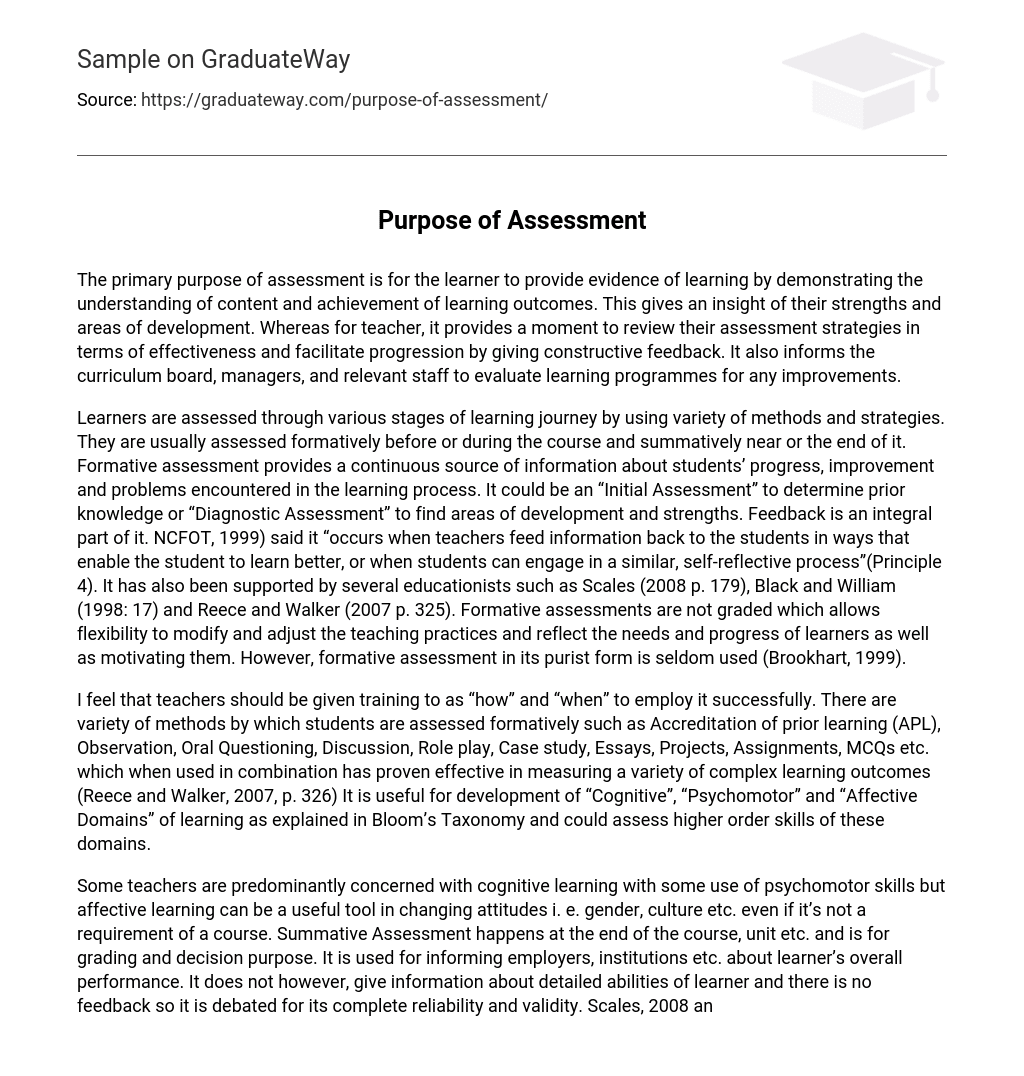The main objective of assessment is for the learner to showcase their understanding of content and accomplishment of learning outcomes, providing evidence of their learning. This also offers crucial insights into their strengths and areas in need of improvement. For teachers, assessment serves as an opportunity to assess the effectiveness of their strategies and enhance progress through constructive feedback. Additionally, it informs curriculum board members, managers, and relevant staff to evaluate learning programs and identify areas for improvement.
The assessment of learners occurs at different stages of their learning journey using a range of methods and strategies. Prior to or during the course, formative assessment is conducted, while summative assessment takes place near the end. Formative assessment continuously provides information on students’ progress, improvement, and challenges throughout the learning process. It can be an “Initial Assessment” to determine prior knowledge or a “Diagnostic Assessment” to identify areas for development and strengths. Feedback plays a vital role in this process by aiding student learning and encouraging self-reflection. According to NCFOT (1999), formative assessment happens when teachers give information or when students engage in self-reflection. Educationists like Scales (2008, p. 179), Black and William (1998, p. 17), and Reece and Walker (2007, p. 325) also support feedback usage. Formative assessments are not graded, allowing flexibility in adjusting teaching practices to meet learner needs and progression while motivating them. However, pure formative assessment is seldom utilized (Brookhart, 1999).
Teachers should be trained on how and when to successfully employ various formative assessment methods such as Accreditation of prior learning (APL), Observation, Oral Questioning, Discussion, Role play, Case study, Essays, Projects, Assignments, MCQs, etc. These methods, when used together, have proven effective in measuring complex learning outcomes (Reece and Walker, 2007, p. 326). They are useful for developing the “Cognitive,” “Psychomotor,” and “Affective Domains” of learning described in Bloom’s Taxonomy and can assess higher order skills in these domains.
The primary focus of some teachers is cognitive learning with some use of psychomotor skills. However, affective learning can also be beneficial in changing attitudes related to gender, culture, etc., even if it is not a requirement of the course. Summative Assessment is typically conducted at the end of the course or unit and is used for grading and decision-making purposes. It provides information to employers and institutions about a learner’s overall performance. However, it does not provide detailed information about the learner’s abilities and lacks feedback, leading to debates regarding its reliability and validity (Scales, 2008 and Rust, 2002). Learners are mainly assessed through examinations, assignments, portfolios, and essays in summative assessment. These assessments help develop cognitive and psychomotor skills depending on their effectiveness and the type of course. Multiple-choice questions (MCQs) and viva tests can provide better coverage of the syllabus and assess deep knowledge, while essays assess higher levels of cognitive domain such as synthesis and evaluation. Feedback plays a crucial role in assessment and is directly linked to motivation.
To enhance the learning process, it is important for it to be timely, positive, and constructive. According to Maslow’s hierarchy, which considers various aspects such as physiological factors, relationships (including positive regard and development feedback), and self-esteem needs (such as feeling inadequate), this hierarchy serves as a helpful tool in understanding learning and motivation (Scales, 2008, p. 72). It is necessary to maintain records in order to track and monitor the progress of learners. These records can be of various types, including internal, external, formal, and informal.
Internal records consist of various documents such as mark books, matrix, learner progress sheets/reviews, and results of mock tests. In the ESOL department, we maintain records of the Initial interview, Initial assessment, spiky profile, ILPs (Individual Learning Plans), Diagnostic assessment, Formative assessment, observation reports, feedback reports, peer/self assessments, and Summative assessments. These records are used to gauge the progress of learners and the effectiveness of the program and teaching. External records encompass all the evidence in the form of written work or internal verification that is sent to external bodies such as exam boards, auditing bodies, other educational organizations, and support staff.





